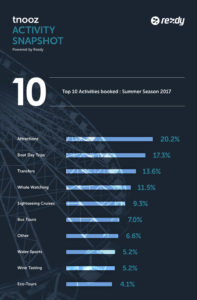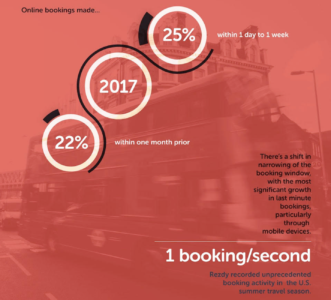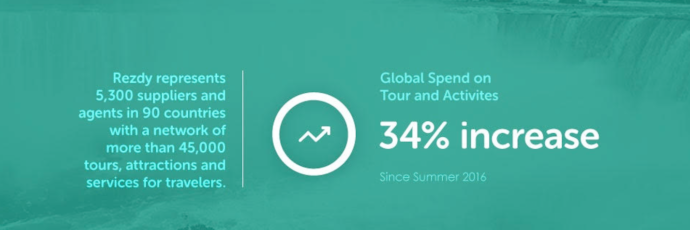
In-destination with the Tours and Activities Snapshot for 2017
By cameron in Uncategorized
Tours and activities are a growing part of the travel industry. This growth continues to garner more attention for this segment of the industry, as more technology providers vie for the business of connecting inventory to digital distribution channels, as well as helping tour operators run their businesses more efficiently. And with many operators still relying on analog inventory management — also known as pen and paper — the opportunity in serving these operators is significant.
Beyond the digitization of inventory and process, there’s another fundamental shift powering growth for the in-destination segment: shifts in consumer behavior. Driven by the “rise of the experiential,” consumers are both seeking more novel experiences while traveling and booking these experiences closer to their departure date.
Case in point: Airbnb’s Trips offering, which extends the company’s hipster cachet from unique homestays to memorable things to do with locals. And with Airbnb’s fastidious focus on the mobile experience, more consumers than ever are being exposed to quick-and-painless ways to book cool things to do at the last minute.
The velocity of expectations is such that consumers are not only used to buying things but also eager to explore destinations with an open mindset. This makes for plenty of ways to engage travelers through appealing tours, engaging descriptions, and seamless mobile booking experiences.
Much of these trends were covered in detail at this year’s inaugural Arival conference for the in-destination segment, where tnooz had a prime spot to explore the state of the industry as part of our tnoozLIVE@Arival coverage.
Our presenting partner for the live show was technology provider Rezdy. As part of our ongoing efforts to highlight the sector, Rezdy has agreed to provide periodic insights culled from their data, exclusive to the tnooz community. We’re working to follow this view into the tours and activities industry with even more detailed observations.
The top activities booked during the summer season
Destinations are often defined by the activities available there. Yet there are certain trends that define the traveler’s expectations of what types of activities should be in a particular place, says Rezdy CEO Simon Lenoir:
“We are certainly seeing some macro trends across destinations globally. Some type of experiences such as Escape Room are growing extremely fast, with businesses opening daily somewhere in the world. Another interesting — and very early — trend is in eGames and immersive experiences such as VR-based attractions. Wineries and breweries tours are also booming, as it’s all about seeing the way things are made. Especially those things that are local specialties.”

View the full-size graphic here.
Last minute mobile bookings growing continuously
With the exception of tours that involve complex itineraries at higher prices, last-minute bookings are growing continuously — driven by consumers booking via mobile. This means that the mobile browsing and checkout experience matters more than ever for tour operators.

View the full-size infographic here.
Another key point, says Lenoir, is that online direct bookings are growing: “Consumers don’t want to talk to someone anymore.” Other data showing the vitality of mobile booking:
“Mobile bookings have been growing 1 percent per quarter consistently for the last 4 years. This means that the overall share of mobile bookings has grown from 30 percent a few years ago to 45 percent currently. Please note I am not referring to browsing but making the booking. So transactions and payment.”

View the full-size infographic here.
One of the key benefits of distributing inventory via OTAs, says Lenoir, is that these companies have invested heavily in mobile technology and booking software that provides real-time confirmation to travelers. This makes for a better user experience, which increasses loyalty — and makes it even harder for operators to capture direct bookings.
“OTAs are clearly gaining market shares, so suppliers need to make their own direct channel (their website) competitive, which is not possible when they charge 6 percent fee on top of the normal price. Direct booking should be the supplier’s most profitable channel.
Hotels have learned that lesson a long time ago. Consumers are savvy and have the power to shop around easily. That’s the reason that OTAs don’t charge booking fees — they know too well it’s killing conversion.”
A growing industry
The expansion of platforms where travelers can book in-destination experiences has created a boom for the in-destination segment. The diversity in selection also means greater competition, as travelers now have a plethora of options on what and where to book in-destination activities. This increases the imperative for all players — suppliers, vendors, and platforms — to improve the experience so that travelers can book where, how, and when they want.

View the full-size infographic here.
View the full-size infographic here.
![]()

